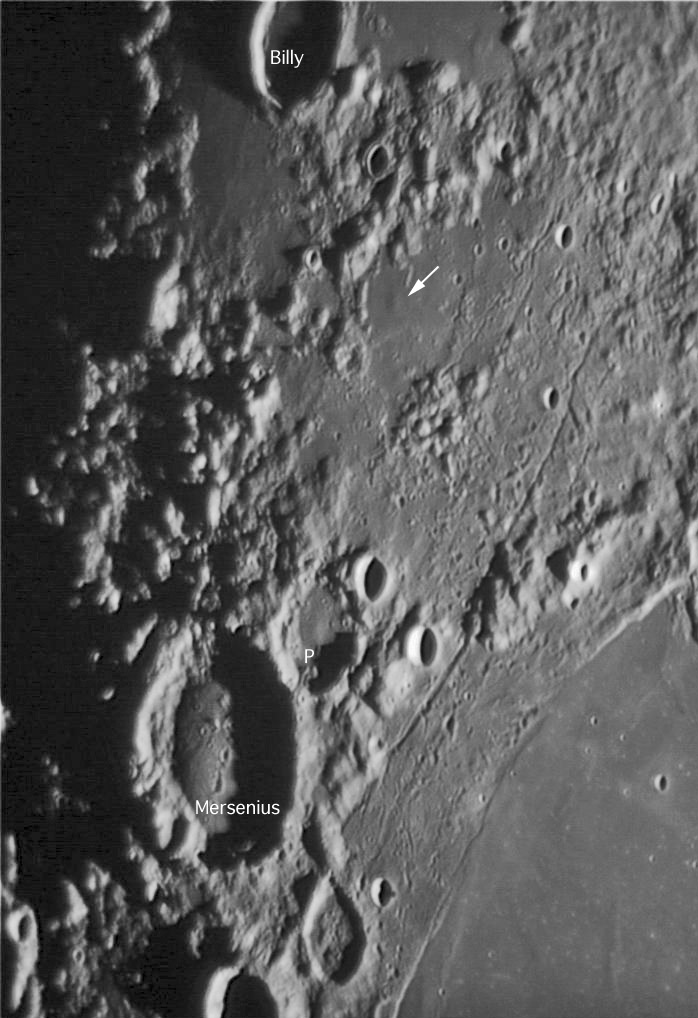Difference between revisions of "LPOD Feb 15, 2008"
(Created page with "<div id="content_view" class="wiki" style="display: block"> =ANOTHER CORNER= <br /> LPOD-Feb15-08.jpg<br /> ''image by [mailto:rafaelbenpal@gmail...") |
|||
| Line 1: | Line 1: | ||
<div id="content_view" class="wiki" style="display: block"> | <div id="content_view" class="wiki" style="display: block"> | ||
=ANOTHER CORNER= | =ANOTHER CORNER= | ||
| − | <br /> [[Image:LPOD-Feb15-08.jpg|LPOD-Feb15-08.jpg]]<br /> ''image by [mailto:rafaelbenpal@gmail.com Rafael Benavides,] Posadas, Córdoba, Spain''<br /> <br /> Rafael has had fabulous luck with Humorum. He has captured excellent images of the [/LPOD%20Feb%207%2C%202008 southeast] and [/LPOD%20Feb%208%2C%202008 southwest] corners of the basin, and now the northwest. His images are low Sun closeups of the region between the maria and outer basin rings. This is typically a swampy area where ejecta, mountain rings and localized puddles of mare lava intermix. And that is what is here, with a variety of rilles, mostly heading northwards. There are also some domes. The biggest definite dome is on the floor of Mersenius P, indicated by its slightly bright sun-facing slope matched with a slightly dusky shadowed side. A somewhat smaller dome (arrow) occurs to the north on the lava-covered floor of a possible ruined crater. Although these two domes look very similar a glance at the Clementine UVVIS multi-spectral [http://www.mapaplanet.org/explorer-bin/explorer.cgi?map=Moon&layers=moon_clementine_multi&west=306.23&south=-20.62&east=317.48&north=-15.00¢er=311.855&defaultcenter=on&grid=none&stretch=none&projection=SIMP&advoption=NO&info=NO&resolution=64 mosaic] shows that the smaller dome formed on dark mare material, but the one in P is on mare-looking stuff that is covered with bright ejecta - it is probably the older of the two domes. A third, possible larger dome is hinted at on the floor of Mersenius, just above the "M". This one occurs where there are many thin rilles and the Clementine image shows a volcanic dark halo at about the same spot. Is it a real dome?<br /> <br /> ''Chuck Wood''<br /> <br /> '''Technical Details'''<br /> Jan 19, 2008. Celestron 11 + Barlow 2X + Luna-QHY 5 mono camera. <br /> Today's LPOD is just a piece of a larger [http://img111.imageshack.us/img111/9282/gassendiopik9.jpg image.]<br /> <br /> '''Related Links'''<br /> Rükl plate<br /> Rafael's [http://algieba.blogalia.com/ website]<br /> <br /> '''[/LPOD%20Index Index] of past LPOD's'''<br /> <br /> '''To post/view [/LPOD%20Comments comments] regarding this LPOD, please click [http://the-moon. | + | <br /> [[Image:LPOD-Feb15-08.jpg|LPOD-Feb15-08.jpg]]<br /> ''image by [mailto:rafaelbenpal@gmail.com Rafael Benavides,] Posadas, Córdoba, Spain''<br /> <br /> Rafael has had fabulous luck with Humorum. He has captured excellent images of the [/LPOD%20Feb%207%2C%202008 southeast] and [/LPOD%20Feb%208%2C%202008 southwest] corners of the basin, and now the northwest. His images are low Sun closeups of the region between the maria and outer basin rings. This is typically a swampy area where ejecta, mountain rings and localized puddles of mare lava intermix. And that is what is here, with a variety of rilles, mostly heading northwards. There are also some domes. The biggest definite dome is on the floor of Mersenius P, indicated by its slightly bright sun-facing slope matched with a slightly dusky shadowed side. A somewhat smaller dome (arrow) occurs to the north on the lava-covered floor of a possible ruined crater. Although these two domes look very similar a glance at the Clementine UVVIS multi-spectral [http://www.mapaplanet.org/explorer-bin/explorer.cgi?map=Moon&layers=moon_clementine_multi&west=306.23&south=-20.62&east=317.48&north=-15.00¢er=311.855&defaultcenter=on&grid=none&stretch=none&projection=SIMP&advoption=NO&info=NO&resolution=64 mosaic] shows that the smaller dome formed on dark mare material, but the one in P is on mare-looking stuff that is covered with bright ejecta - it is probably the older of the two domes. A third, possible larger dome is hinted at on the floor of Mersenius, just above the "M". This one occurs where there are many thin rilles and the Clementine image shows a volcanic dark halo at about the same spot. Is it a real dome?<br /> <br /> ''Chuck Wood''<br /> <br /> '''Technical Details'''<br /> Jan 19, 2008. Celestron 11 + Barlow 2X + Luna-QHY 5 mono camera. <br /> Today's LPOD is just a piece of a larger [http://img111.imageshack.us/img111/9282/gassendiopik9.jpg image.]<br /> <br /> '''Related Links'''<br /> Rükl plate<br /> Rafael's [http://algieba.blogalia.com/ website]<br /> <br /> '''[/LPOD%20Index Index] of past LPOD's'''<br /> <br /> '''To post/view [/LPOD%20Comments comments] regarding this LPOD, please click [http://the-moon.us/wiki/message/list/LPOD+Feb+15%2C+2008 here].'''<br /> <br /> </div> |
Revision as of 19:19, 11 April 2018
ANOTHER CORNER

image by Rafael Benavides, Posadas, Córdoba, Spain
Rafael has had fabulous luck with Humorum. He has captured excellent images of the [/LPOD%20Feb%207%2C%202008 southeast] and [/LPOD%20Feb%208%2C%202008 southwest] corners of the basin, and now the northwest. His images are low Sun closeups of the region between the maria and outer basin rings. This is typically a swampy area where ejecta, mountain rings and localized puddles of mare lava intermix. And that is what is here, with a variety of rilles, mostly heading northwards. There are also some domes. The biggest definite dome is on the floor of Mersenius P, indicated by its slightly bright sun-facing slope matched with a slightly dusky shadowed side. A somewhat smaller dome (arrow) occurs to the north on the lava-covered floor of a possible ruined crater. Although these two domes look very similar a glance at the Clementine UVVIS multi-spectral mosaic shows that the smaller dome formed on dark mare material, but the one in P is on mare-looking stuff that is covered with bright ejecta - it is probably the older of the two domes. A third, possible larger dome is hinted at on the floor of Mersenius, just above the "M". This one occurs where there are many thin rilles and the Clementine image shows a volcanic dark halo at about the same spot. Is it a real dome?
Chuck Wood
Technical Details
Jan 19, 2008. Celestron 11 + Barlow 2X + Luna-QHY 5 mono camera.
Today's LPOD is just a piece of a larger image.
Related Links
Rükl plate
Rafael's website
[/LPOD%20Index Index] of past LPOD's
To post/view [/LPOD%20Comments comments] regarding this LPOD, please click here.